How to Make Pie Crust for 9x13 Pan Easy
These are the secrets to making a no-fail butter pie crust recipe that won't slump or shrink, and turns out tender and flaky every time.
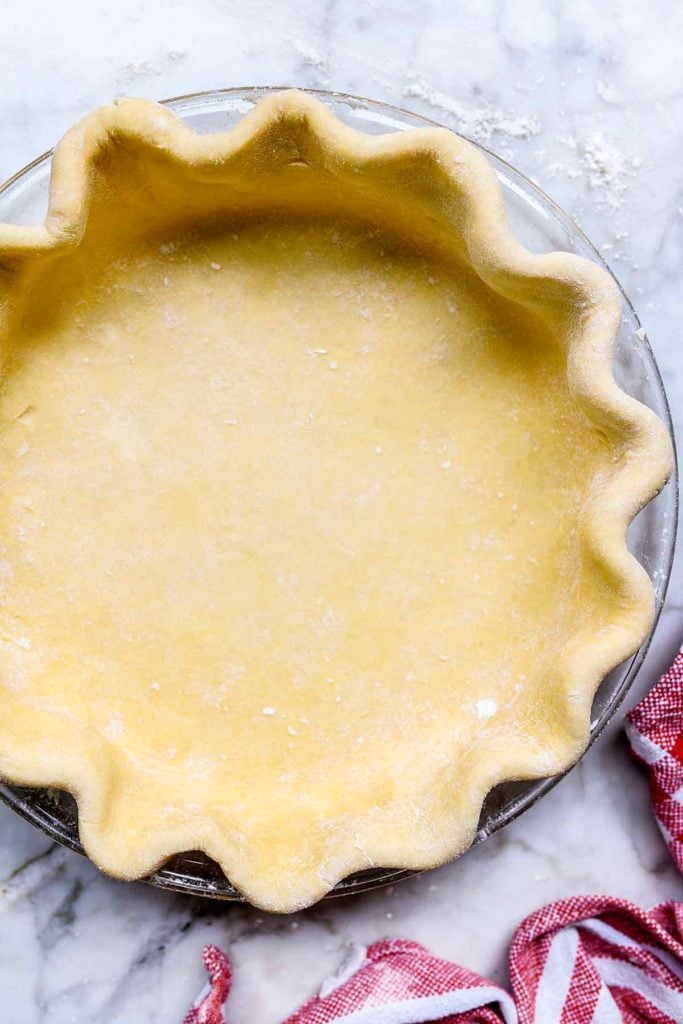
The Best Pie Crust Recipe with Butter
It feels like there are two big pie seasons that hit every year: Spring's berry pie season and Fall's Thanksgiving pie season, with all other slices o' pie falling somewhere in between.
We are smack dab in the middle of prime time pie making and eatingand everyone knows that a foolproof butter pie crust recipe is the make-or-break point of baking an amazing homemade pie. More important than whatever fruity, nutty, or creamy fillings you whip up—the true test is its crust. It should be flaky, light, flavorful, and easy to slice through with a fork.
I'm a bit obsessed with baking pies thanks to the over the top pie crusts I'm incessantly inspired by because of the Instagram account of my favorite local pie company.
Now, after much trial and error, I've decided this is the only pie crust recipe I'm willing to bet my pie on. And now, everything that I know, you will too.
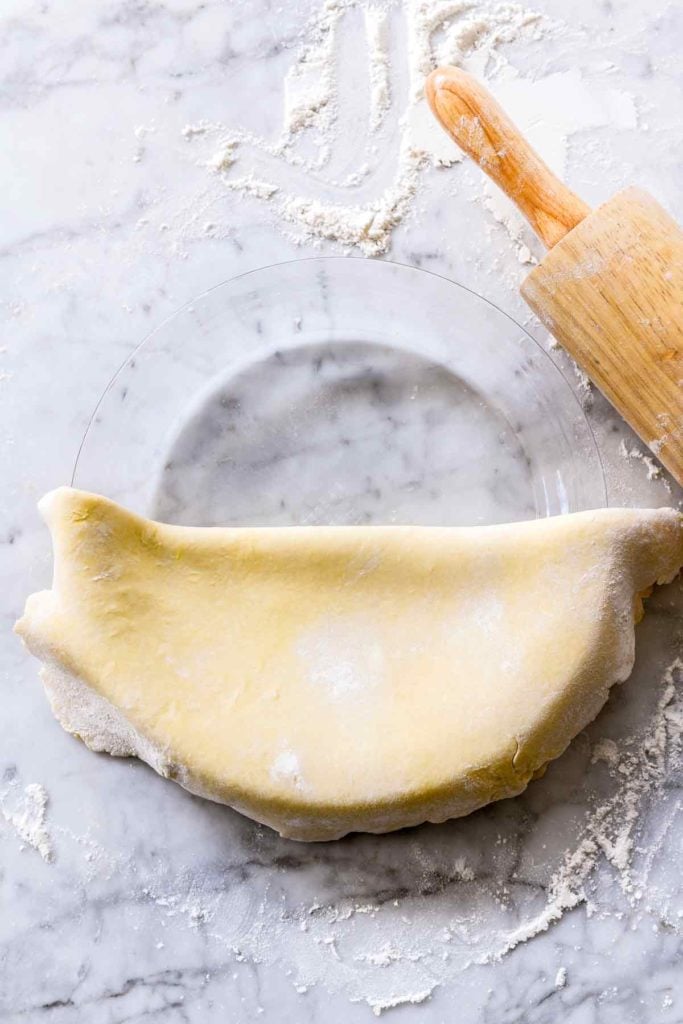
Is Butter or Shortening Better for Making Pie Crust?
All good pie starts with good dough. But how to go about achieving the perfect flaky pie crust has been as hotly debated as whether Madonna or Lady Gaga is the real queen of music.
All butter pie crust vs. shortening: An all butter crust with different size chunks of the fat in your dough makes it flaky and light. Butter contains more water than shortening, so as it bakes the steam puffs up the crust creating light and flaky layers. Shortening can take on a greasier feel, and lacks the same flavor as butter.
All butter pie crust vs. lard: The main issue with using lard is that it can be difficult to get your hands on high quality rendered leaf lard. Lard variations found in grocery stores are often hydrogenated and filled with preservatives.
For me, an all butter pie crust recipe without shortening makes the perfect, flaky pie crust that checks all the flavor boxes.
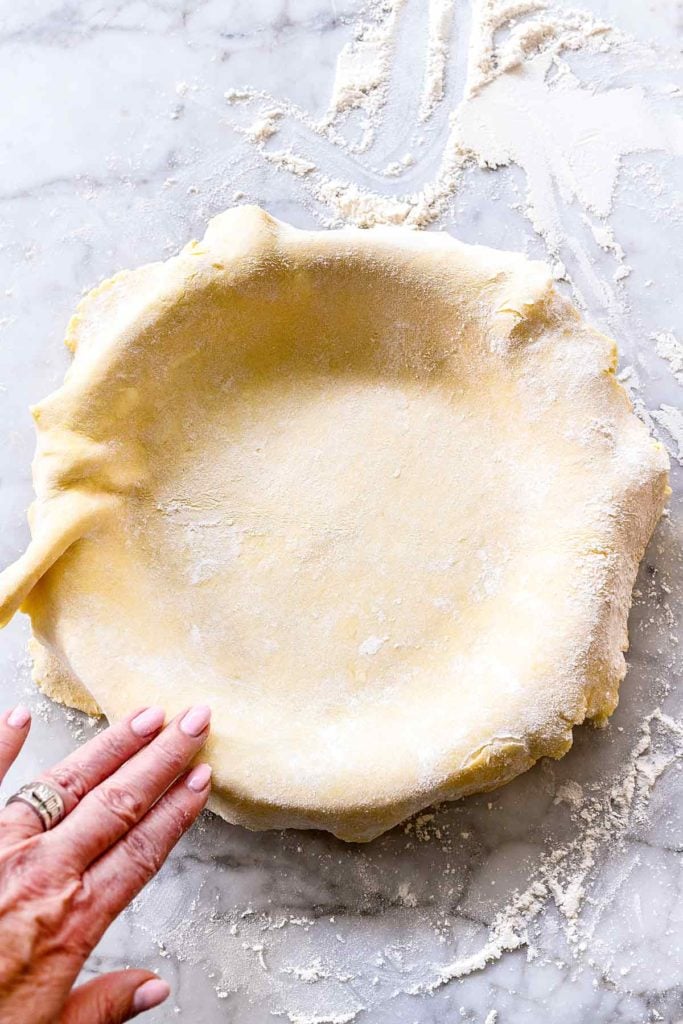
What's in This All Butter Pie Crust
I've tried all the tricks of adding vinegar or vodka to my pie crust to add that extra snap to crust, but in the end it comes down to keeping things chilled for the best flakes. I also add sugar to my dough for a just a slightly sweet taste, and a surprise ingredient for a little more lift and loft: baking powder!
Here's what all you'll need to make the best pie crust:
- All-purpose flour
- Granulated sugar
- Kosher salt
- Baking powder
- Unsalted butter—I love using European butter with 85% fat content for the best results
- Ice cold water
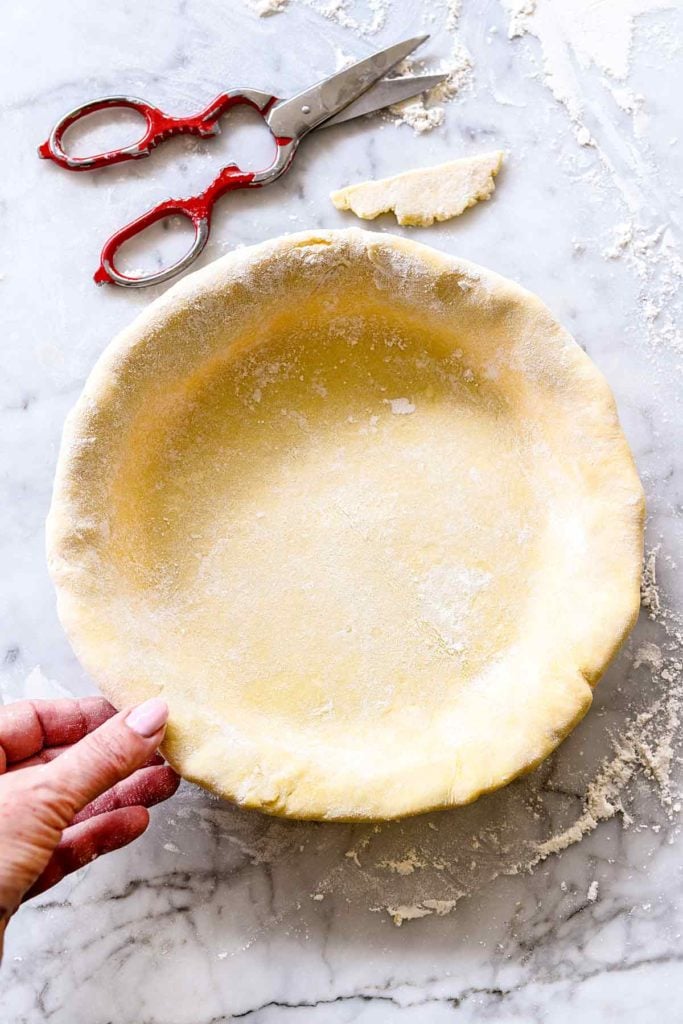
Food Processor or Pastry Blender for Pie Crust: Which is Better?
You want chunks of fat in your pie dough, which in this case is the butter. The processed or cut-in butter chunks in the dry dough should be the size of cornmeal, peas, almonds and walnuts, aka a mixture of smooth, small, and big chunks of butter for the flakiest texture.
Process the butter in stages. To achieve this, use either a food processor to pulse half of the butter (3 to 4 pulses), or a pastry blender to hand-cut it into the variety of fatty sizes. Add the rest of the butter and repeat. I've found the food processor is usually the easiest method so it's typically what I use.
Use quick pulses. When using the food processor, be sure to use quick pulses, not long processing, or you'll lose your chunks of butter. Add just enough water to barely bring the dough together.

How to Make Pie Crust
Using either the food processor method or pastry blender method outlined above, make the pie dough. Then, dump the dough onto a lightly floured surface and use a bench scraper to drag and scrape the dough and butter together, creating ribbons of shaggy dough folded onto itself.
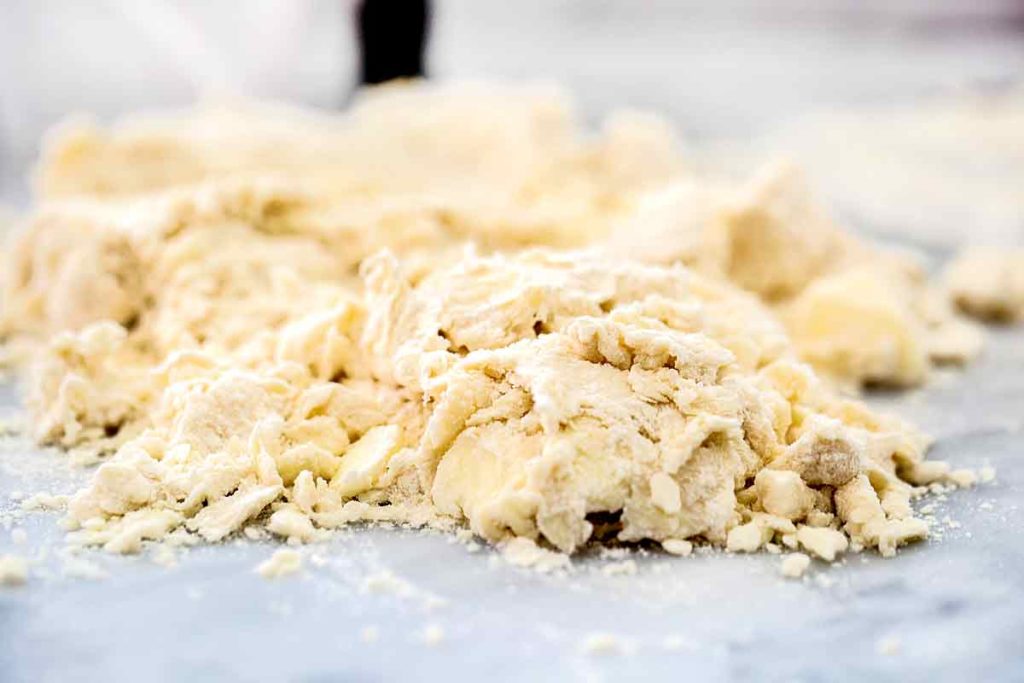
Add more water a little at a time until you can shape the dough into a ball. Cut the ball in half to make two, wrap in plastic wrap, and refrigerate for at least 30 minutes up to 4-5 days, or freeze for up to a year.
Don't knead the dough or it will make too much gluten and the crust will be tough. Also avoid over handling the dough, especially with warm hands, or the butter will melt.
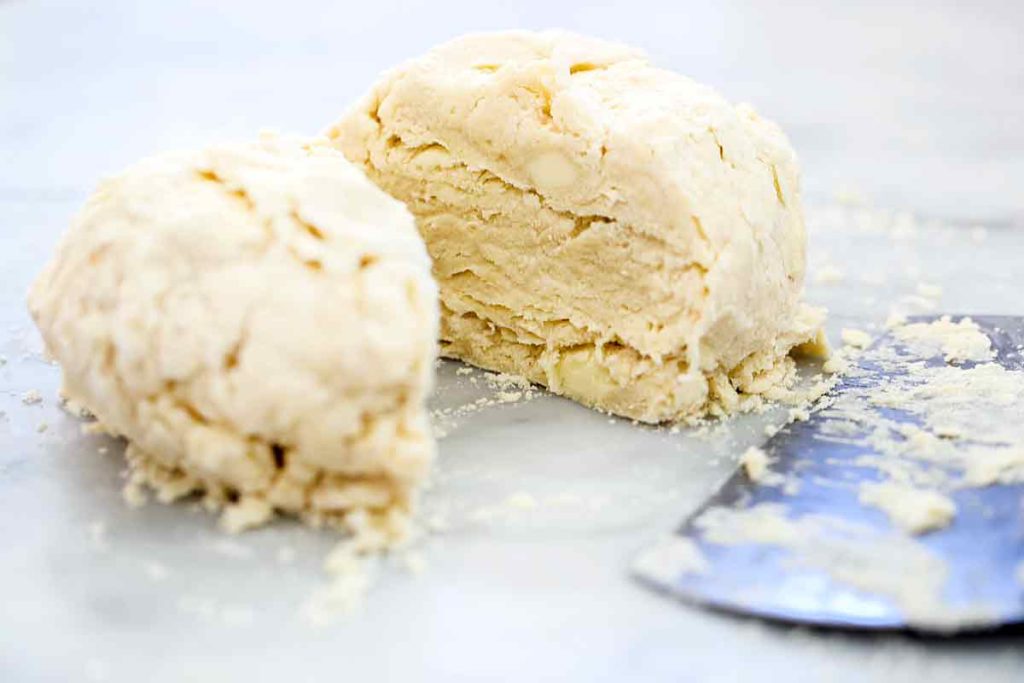
Once you're ready to roll your dough, remove it from the fridge to a lightly floured countertop. Use your fingers to make indentations along the outside circle of the pie disc before rolling (this helps prevent the edges from cracking). Pound the dough with the rolling pin to warm it slightly as it flattens and becomes more pliable.
When it comes to rolling out the dough think of unfurling a flag, not steamrolling it. First, roll all along the outside edge of the pie dough to flatten it slightly. Then, starting from the center of the dough, roll the dough, rotating it with every few swipes, until it reaches the size you're looking for, about 12 to 13 inches for a 9-inch pie pan.
Tip: To know how large a circle you need for your pie, invert a pie tin and set it lightly on the dough and cut a circle around the tin about 2-3 inches bigger than the tin's edges.
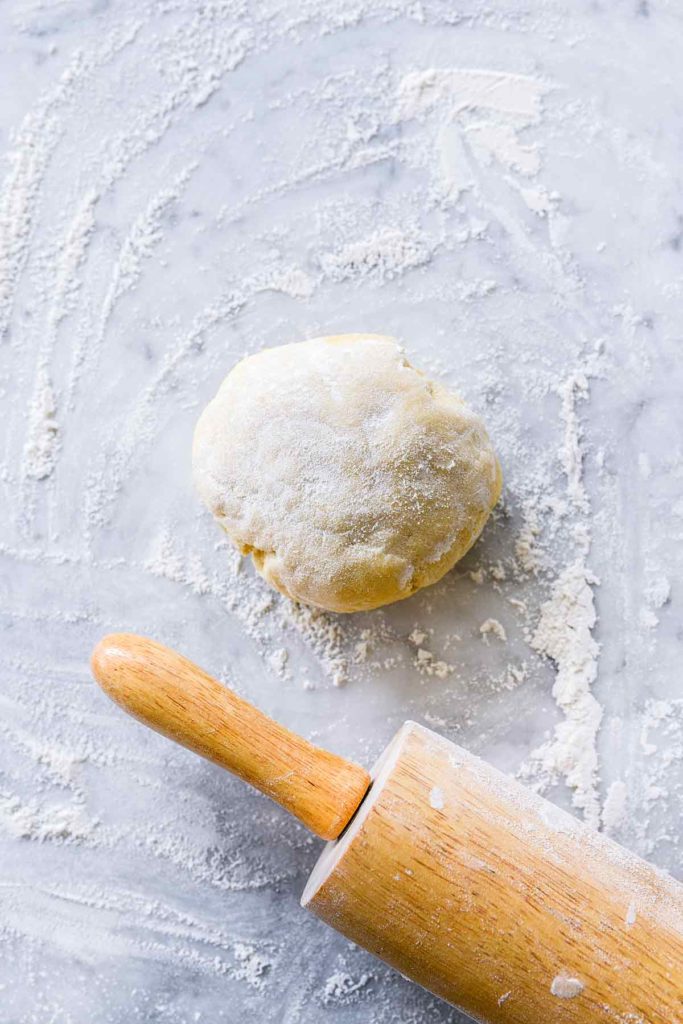
How to Crimp Pie Crust
- Crimping a pie crust can be as easy as using the tines of a fork to secure the edges, however as I mentioned at the top of this post, I love a big, Dr. Seuss looking pie crust just for the drama alone.
- Use your fingers to gently roll the overhang of the dough either under itself toward the outside edge of the tin, or, toward the center of the pie, so it forms a ring on top as you move along the edge, sealing the edge as you go.
- Crimp the dough using your thumb and index fingers to crimp the dough, firmly. Move clockwise until the crimped ring is complete.
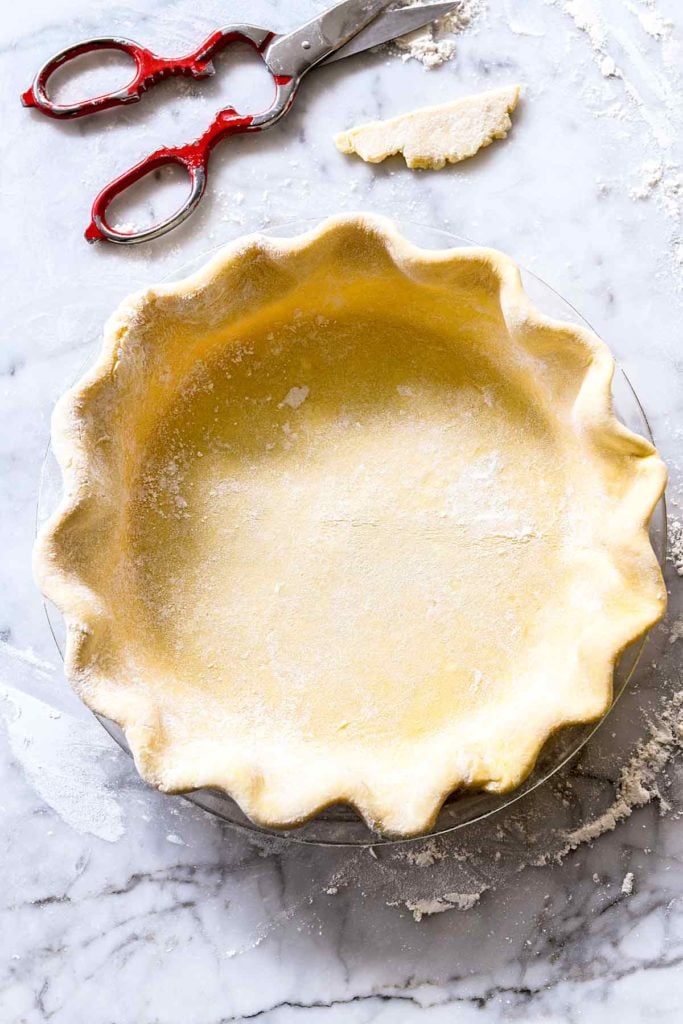
How to Crimp Crust With Authority
One of my favorite local pie makers shared how they crimp pie dough in the video below.
How to Blind Bake Pie Crust for Single Crust Pies
Blind baking a crust before filling is essential for those loose pie fillings like quiches or pies that aren't baked, such as fresh fruit pies or cream and pudding-like pies. Bling baking is simply pre-baking a single layer pie crust before filling it to ensure it's flakey and cooked instead of soggy or underdone.
Tip: Pies can be blind baked up to 2 days in advance, and wrapped carefully and tightly with plastic wrap.
Double crust pies don't require blind baking since the crust will need to be filled and crimped with both bottom and top pie dough discs before going in the oven, and the filling acts the same as the pie weights or beans so the crust doesn't slump.
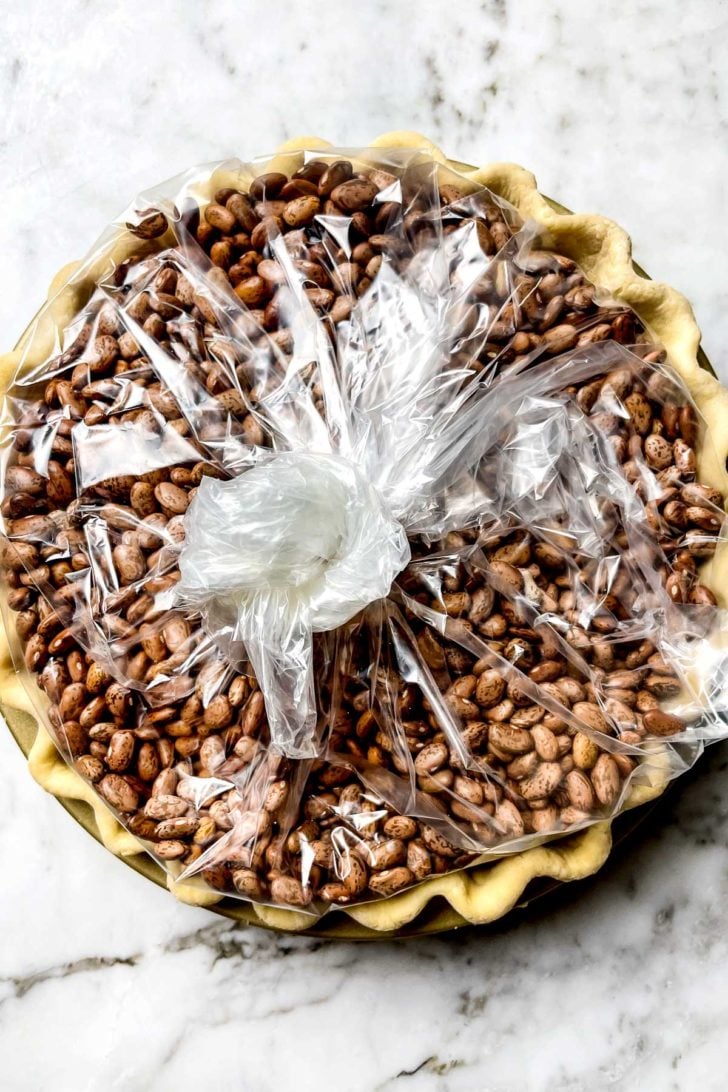
How to Avoid the Crust Slump
One of the casualties of blind baking an empty pie crust is sides that slump and slide into the middle of the pie tin so there's no sides left to be had.
Use beans in a bag for blind baking crusts. I discovered a new way to blind bake my pie crust that works like a charm. Fill an oven-safe cooking bag with 6 cups of dry beans, uncooked rice, or pie weights. Place the bagged beans in the semi-frozen, crust-lined pan then put directly into the oven. When finished, lift the bag of beans from the crust and save the beans in the bag for another baking day.
After seeing these tips from my friend Elise at Simply Recipes, I gave up trying to remember whether hot and fast, or low and slow was best for success. I went with her suggestion to blind bake the crust in a 350°F oven for a longer time, and it works like a charm—and it's totally simple to remember.
- For a pie that you will cook further, like a quiche, blind bake the crust at 350°F for 45-50 minutes.
- For pies that need no further baking, like fresh fruit or custard pies, blind bake the crust at 350°F for 60-70 minutes.
Freeze the pie crust for 30 minutes before baking. Baking a pie crust frozen solid helps the crimps hold shape and not melt in the hot oven.
Toward the end of baking, check in on the pie crust. If it's browning too much, protect the edges from the heat with strips of foil tented gently over the edges, or use a pie shield.
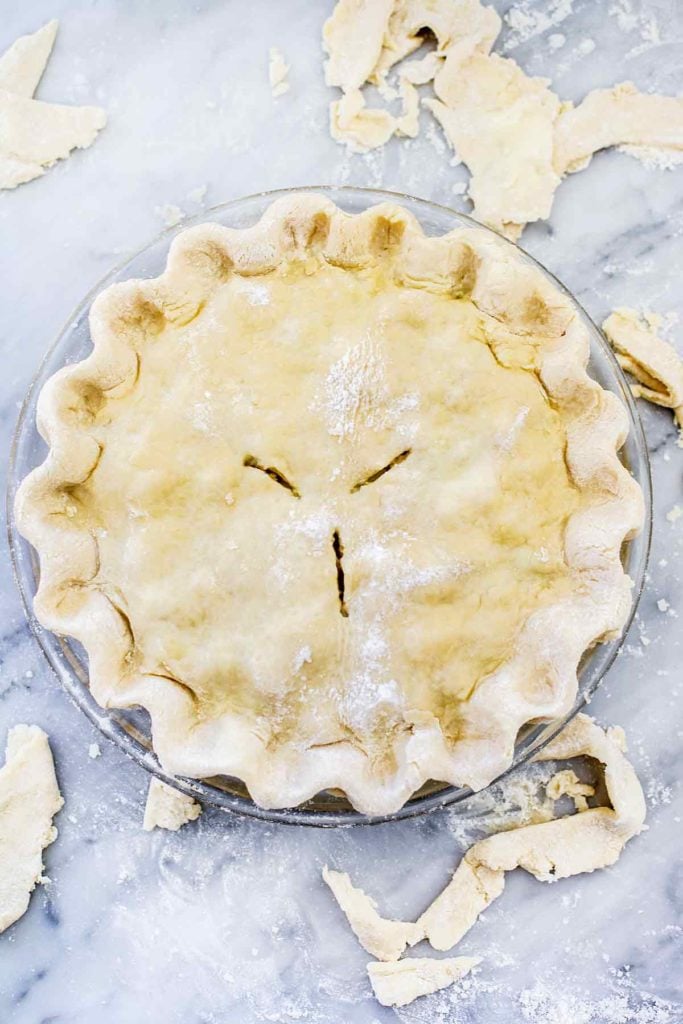
Tips for Making Double Crust Pies
- Just like single crust pies, be sure your pie crust discs have been refrigerated for at least 30 minutes before rolling out and placing in baking tins.
- Because double crust pies like pot pies or apple pies already have a filling and need the top and bottom crusts pliable enough to crimp and seal, there's no need to blind bake the pies beforehand.
- Additionally, you only need to freeze the assembled pies for only 15-30 minutes, just to firm up before putting into the hot oven.
How to Prevent a Soggy Pie Crust
- Brush the bottom crust with a whisked egg white before adding the filling, creating a barrier between the filling and the crust.
- Bake in a glass pie dish to monitor the browning of the crust.
- Set on a pre-heated baking sheet while baking so the heat is conducted directly to the bottom of the pie crust.
- Steam vents look pretty on top of a double crust pie but also serve a purpose, allowing the steam to escape as the pie bakes so the top crust stays flaky and crisp, not soggy.
How Long You Can Freeze Pie Crust
Wrapped tightly with plastic wrap and stored in a freezer-safe gallon bag, pie discs and crimped pie crusts can be stored in the freezer for up to one year.
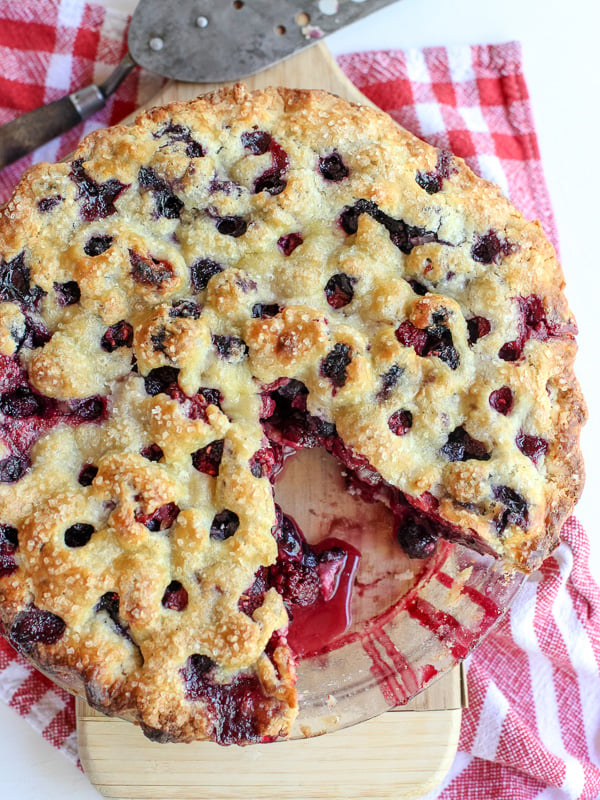
Tips for Making the Best Pie Crust
If you want to make an insanely flaky homemade pie crust, there are two key things to keep in mind:
Use a high-quality unsalted, butter for pie crust. When making pie crust I splurge on a good European-style brand with 85% fat content. Full-fat butter is where the flavor lies, with a high butterfat percentage and low water content. Sure, I've made pie crust with salted butter, but unsalted allows you to better control the amount yourself.
Make sure your butter is really, really cold. Sticking it in the freezer for 15 minutes helps. But before you do, use a bench scraper to cut the sticks of butter into 1/2 inch cubes, then freeze if desired. Or, work quickly so your butter stays cold and go straight into the mixing.
Cold ingredients, especially the butter and the water, keep those buttery fat flavor pockets solid and stand-alone when the heat hits the butter rather than warm and homogenized in the dough, creating sheaths of flaky layers. Fill a 1-cup measuring cup half way with ice cubes and the rest water and add a few tablespoons of water at a time for a shaggy crust.
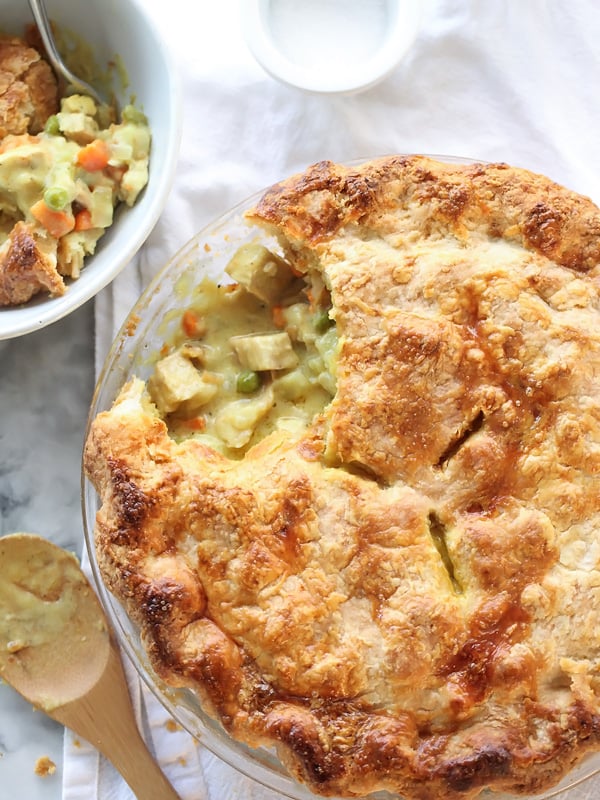
Some of My Favorite Reasons to Make Pie Crust…So Far!
- The Best Four Berry Pie Recipe
- Curry Turkey Pot Pie
- Quick Rustic Apple Tart
- Mountain Fresh Peach Pie
- Spinach, Artichoke and Goat Cheese Quiche
- Rhubarb Raspberry Pie with Oatmeal Crumble
- Raspberry Peach Hand Pies
- Skillet Cherry Pie
- Caramel Apple Pie
If you mak e this recipe, please let me know! Leave a




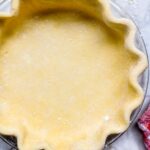
The Best No-Fail All Butter Pie Crust
This all butter pie dough recipe makes enough filling for two 9-inch pie pans or for one 9 X 13 baking dish. If using 9-inch pie pans make 2 recipes of the pie dough for 2 pies with a double crust. If using a 9 X 13 pan, one recipe of pie crust will top one single top crust pot pie.
Servings 2 9-inch pie crusts
Calories 1480 kcal
- 12 ounces all-purpose flour
- 2 tablespoons sugar , (if making a sweet pie)
- 1 teaspoon kosher salt
- 1 teaspoon baking powder
- 8 ounces unsalted butter , cut into 6-8 pieces and frozen in a zip-top bag
- 4-5 ounces ice-cold water
To Make the Pie Crust
-
In the bowl of a food processor, add the flour, sugar, salt, and baking powder and pulse 2-3 times to blend. Add the butter, separating the pieces if they're stuck together, and toss them with the flour mixture. Pulse the flour mixture until there is a mixture of almond/walnut-size pieces and pea-size pieces, about 7-10 pulses. Drizzle the cold water over the butter-flour mixture and pulse 3-4 more times.
-
To make the pie dough in a bowl, mix together the flour, salt and sugar. Add the butter, separating the pieces if they're stuck together, and toss them with the flour mixture. Cut the butter into the flour mixture until there is a mixture of almond/walnut-size pieces and pea-size pieces. Drizzle the water over the butter-flour mixture. Mix with fork.
-
Dump the mixture on the counter. It should be loose and unincorporated. Use a bench scraper to gather the crumbs into the mass of dough. Use the heel of your hand to smear the mixture away from you one-third at a time. If the mixture is still dry rather than crumbly, add more water a tablespoonful at a time, sprinkling it over the dough. Gather the dough together with the bench scraper. Repeat again and then again if necessary.
-
Cut the dough in half with the bench scraper and form each half into a puck shape. Wrap in plastic wrap and refrigerate for at least 30 minutes.
To Roll the Pie Crust
-
Pull one of the dough pucks from the refrigerator and place on the countertop sprinkled with flour and sprinkle the dough with a bit of flour too. Use your fingers to make indentations along the outside circle of the pie disc before rolling (this helps prevent the edges from cracking). Rub some flour on the rolling pin then rap the dough with the rolling pin 6-8 times to soften it. Flip the dough over, lightly dust it with flour and rap the dough again, this time in the opposite direction.
-
Starting from the middle of the dough, roll the dough away from you, giving it a quarter turn after each couple of passes. Flip the dough over and once again roll the dough from the middle outward, giving the dough a quarter turn each time, dusting the flour and the roller as needed.If any of the butter breaks through the surface, dab with a bit of water and join the pieces together, then sprinkle some flour over the exposed area and brush away the excess.
-
Roll the dough to a few inches larger than your 9-inch glass pie pan. Gently fold the dough in half and in one movement lift it off the rolling surface and into the pan. Unfold the dough circle and gently ease it into the pan. Don't stretch the dough down into the pan or it will bounce back and shrink when it heats up in the oven. Repeat with the other disc of pie dough.
-
For a single crust pie, cover with plastic wrap and freeze the dough in the pie pan for at least 30 minutes or up to 1 month before baking.
-
For a double crust pie, fill your pie with filling, add the top pie crust and crimp the edges. Cover with plastic wrap and freeze for 30 minutes before baking or freeze for up to 1 month.
To Blind Bake the Pie Crust
-
Preheat the oven to 350°F.
-
Take the pie crust from the freezer and line the dough with heavy-duty aluminum foil, pressing into the edges with the edges of the foil falling over the sides making it easy to lift out later. Fill to the top crust's lip with pie weights, dry beans, or sugar.
-
Bake for 45-50 minutes for a pie that you will cook further, like a quiche. Bake for 60-70 minutes for pies that need no further baking, like fresh fruit or custard pies.
-
Remove the pie shell from the oven. Lift out aluminum foil with the pie weights using the overhanging foil. Let the pie weights cool and save for future pie crust baking.
Keep watch during the final 20-30 minutes of baking and if the crust is browning too quickly, gently cover the edges with aluminum foil or a pie crust protector.
Calories: 1480 kcal | Carbohydrates: 142 g | Protein: 18 g | Fat: 93 g | Saturated Fat: 58 g | Cholesterol: 243 mg | Sodium: 1180 mg | Potassium: 411 mg | Fiber: 4 g | Sugar: 12 g | Vitamin A: 2835 IU | Calcium: 139 mg | Iron: 8.1 mg

Kitchen Gadgets You May Need to Make Pie Crusts
- 10 to 14-cup food processor
- Dough blender/pastry cutter
- Stainless steel bench scraper
- Rolling pin
- 9-inch glass pie pan or aluminum pie tins
- Pie crust protector
We send good emails. Subscribe to FoodieCrush and have each post plus exclusive content only for our subscribers delivered straight to your e-mail box.
Follow me on Instagram, Facebook, Pinterest and Twitter for more FoodieCrush inspiration.
As always, thank you for reading and supporting companies I partner with, which allows me to create more unique content and recipes for you. There are affiliate links in this post of which I receive a small commission. All opinions are always my own.
Source: https://www.foodiecrush.com/butter-pie-crust/
0 Response to "How to Make Pie Crust for 9x13 Pan Easy"
Publicar un comentario